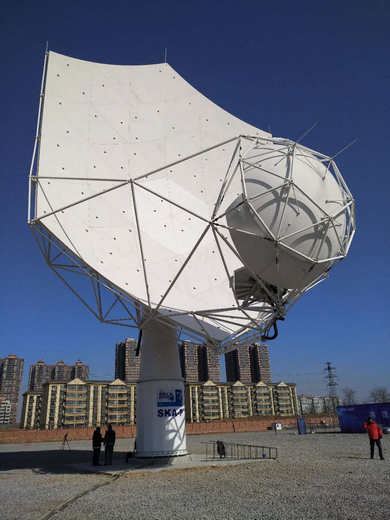


Plans for the world's largest radio telescope able to search for extraterrestrial life took a giant leap forward with completion of a prototype antenna announced by a Hebei Province company on Tuesday.
China will manufacture 2,500 more antennas for the Square Kilometer Array (SKA), the largest and most sensitive radio telescope in the world.
The project brings together top scientists, engineers and policymakers from 20 countries. In its first phase, the SKA will consist of two telescopes, each made up of thousands of antennas. Their signals will be combined by supercomputers to produce previously unattainable information about the universe, according to the SKA project website.
Designed by the 54th Research Institute of China Electronics Technology Group Corporation based in the North China city of Shijiazhuang, the antenna is bigger than half a basketball field, with two reflectors, the Global Times reporter saw at an inauguration ceremony on Tuesday.
The accuracy of the main reflector was "within 0.5 millimeters and the second reflector is within 2 millimeters," chief designer Du Biao told the Global Times.
"The successful manufacture of the antenna marks the moment when China plays a leading role in SKA core equipment," Liu Liehong, general manager, told the Global Times. "China offers an antenna solution to the world."
The SKA telescope project boasts a combined collection area of about one square kilometer, or about 140 soccer pitches, the Xinhua News Agency reported.
With its headquarters based at Jodrell Bank near Manchester, the project will deploy thousands of antennas across Africa and Australia with the goal of completely changing people's understanding of the universe, Xinhua said.
The aim of the project is to help astronomers study the sky with an unprecedented level of detail, according to the Xinhua report.
"We want to try to understand the formation of planets, and even detect signals from extraterrestrial civilizations if they exist," SKA director general Philip Diamond was quoted as saying by Xinhua.
 Fire brigade in Shanghai holds group wedding
Fire brigade in Shanghai holds group wedding Tourists enjoy ice sculptures in Datan Town, north China
Tourists enjoy ice sculptures in Datan Town, north China Sunset scenery of Dayan Pagoda in Xi'an
Sunset scenery of Dayan Pagoda in Xi'an Tourists have fun at scenic spot in Nanlong Town, NW China
Tourists have fun at scenic spot in Nanlong Town, NW China Harbin attracts tourists by making best use of ice in winter
Harbin attracts tourists by making best use of ice in winter In pics: FIS Alpine Ski Women's World Cup Slalom
In pics: FIS Alpine Ski Women's World Cup Slalom Black-necked cranes rest at reservoir in Lhunzhub County, Lhasa
Black-necked cranes rest at reservoir in Lhunzhub County, Lhasa China's FAST telescope will be available to foreign scientists in April
China's FAST telescope will be available to foreign scientists in April "She power" plays indispensable role in poverty alleviation
"She power" plays indispensable role in poverty alleviation Top 10 world news events of People's Daily in 2020
Top 10 world news events of People's Daily in 2020 Top 10 China news events of People's Daily in 2020
Top 10 China news events of People's Daily in 2020 Top 10 media buzzwords of 2020
Top 10 media buzzwords of 2020 Year-ender:10 major tourism stories of 2020
Year-ender:10 major tourism stories of 2020 No interference in Venezuelan issues
No interference in Venezuelan issues
 Biz prepares for trade spat
Biz prepares for trade spat
 Broadcasting Continent
Broadcasting Continent Australia wins Chinese CEOs as US loses
Australia wins Chinese CEOs as US loses